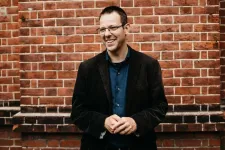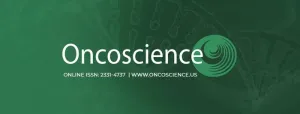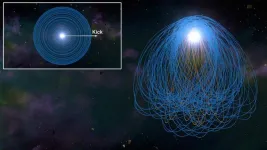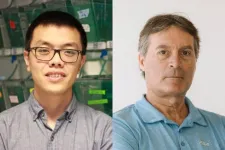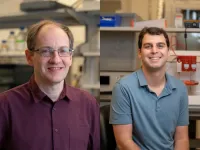(Press-News.org) Researchers from North Carolina State University and the University of Pittsburgh studied how the spin information of an electron, called a pure spin current, moves through chiral materials. They found that the direction in which the spins are injected into chiral materials affects their ability to pass through them. These chiral “gateways” could be used to design energy-efficient spintronic devices for data storage, communication and computing.
Spintronic devices harness the spin of an electron, rather than its charge, to create current and move information through electronic devices.
“One of the goals in spintronics is to move spin information through a material without also having to move the associated charge, because moving the charge takes more energy – it’s why your phone and computer get hot when you use them for a long time,” says David Waldeck, professor of chemistry in Pitt’s Kenneth P. Dietrich School of Arts and Sciences and co-corresponding author of the work.
Chiral solids are materials that cannot be superimposed on their mirror image – think of your left and right hands, for example. A left-handed glove does not fit on your right hand, and vice-versa. Chirality in spintronic materials allows researchers to control the direction of spin within the material.
“Prior to this work, it was thought that the sense of chirality, or ‘handedness,’ of a material was very important to how and whether the spin would move through that material,” says Dali Sun, associate professor of physics, member of the Organic and Carbon Electronics Lab (ORaCEL) at North Carolina State University and co-corresponding author of the work.
“And when you’re moving the whole electron through the material that is still true. But we found that if you inject pure spin into a chiral material, the absorption of spin current strongly depends on the angle between the spin polarization and chiral axis; in other words, whether the spin polarization is aligned parallel or perpendicular to the chiral axis.”
“We used two different approaches, microwave particle excitation and ultrafast laser heating, to inject pure spin into the selected chiral materials in this study, and both approaches gave us the same conclusion,” says Jun Liu, associate professor of mechanical and aerospace engineering, member of ORaCEL at NC State and co-corresponding author of the work.
“The chiral materials we chose are two chiral cobalt oxide thin films, each with a different chirality, or ‘handedness,’” Liu says. “Non-chiral cobalt oxide thin films are commonly used in modern electronics.”
When the team injected pure spin aligned perpendicular to the material’s chiral axis, they noted that the spin did not travel through the material. However, when the pure spin was aligned either parallel or anti-parallel to the chiral axis, its absorption, or ability to pass through the material, improved by 3000%.
“Since spin can only pass through these chiral materials in one direction, this could enable us to design chiral gateways for use in electronic devices,” Sun says. “And this work also challenges some of what we thought we knew about chiral materials and spin, which is something we want to explore further.”
The work appears in Science Advances and is supported by the Department of Energy under award numbers DE-SC0020992 and ER46430; the Air Force Office of Scientific Research, Multidisciplinary University Research Initiatives (MURI) Program under award numbers FA9550-23-1-0311and FA9550-23-1-0368; and the National Science Foundation under award numbers DMR 2011978 and NSF-ECCS 2246254.
NC State postdoctoral researcher Rui Sun, NC State graduate student Ziqi Wang, and University of Pittsburgh Research Assistant Professor Brian Bloom are co-first authors.
-peake-
Note to editors: An abstract follows.
“Colossal Anisotropic Absorption of Spin Currents Induced by Chirality”
DOI: 10.1126/sciadv.adn3240
Authors: Rui Sun, Ziqi Wang, Andrew H. Comstock, Cong Yang, Aeron McConnell, Brian P. Bloom, Jun Liu, Dali Sun, North Carolina State University; Caleb Clever, Mary Molitoris, Daniel Lamont, David H. Waldeck, University of Pittsburgh; Zhao-Hua Cheng, Chinese Academy of Sciences; Zhe Yuan, Beijing Normal University; Wei Zhang, University of North Carolina Chapel Hill; Axel Hoffmann, University of Illinois Urbana-Champaign
Published: May 3, 2024 in Science Advances
Abstract: The chiral induced spin selectivity (CISS) effect, in which the structural chirality of a material determines the preference for the transmission of electrons with one spin orientation over that of the other, is emerging as a design principle for creating next-generation spintronic devices. CISS implies that the spin preference of chiral structures persists upon injection of pure spin currents and can act as a spin analyzer without the need for a ferromagnet. Here, we report an anomalous spin current absorption in chiral metal oxides that manifests a colossal anisotropic non-local Gilbert damping with a maximum-to-minimum ratio of up to 1000%. A two-fold symmetry of the damping is shown to result from differential spin transmission and backscattering that arise from chirality-induced spin-splitting along chiral axis. These studies reveal the rich interplay of chirality and spin dynamics and identify how chiral materials can be implemented to direct the transport of spin current.
END
Researchers from the University of Portsmouth have unveiled a quantum sensing scheme that achieves the pinnacle of quantum sensitivity in measuring the transverse displacement between two interfering photons.
This new technique has the potential to enhance superresolution imaging techniques that already employ single-photon sources as probes for the localization and tracking of biological samples, such as single-molecule localization microscopy with quantum dots.
Traditionally, achieving ultra-high precision in nanoscopic techniques has been constrained by the limitations of standard imaging methods, such as the diffraction limit ...
MSU has a satellite uplink/LTN TV studio and Comrex line for radio interviews upon request.
EAST LANSING, Mich. – Reforestation efforts to restock depleted forests are important for addressing climate change and for both capturing and restoring carbon from the Earth’s atmosphere. These types of solutions to mitigate carbon emissions are critical after 2023 proved to be the warmest year on record. However, some models have been found to be inaccurate.
New research from Michigan State University has found the carbon removal potential of some reforestation models have been over exaggerated ...
Acute myeloid leukemia (AML) is a type of blood cancer that forms in the soft marrow of the bones, typically attacking cells that would otherwise form the key component of the body’s immunodefense system, white blood cells.
In a new study published in Blood Advances, researchers from the UChicago Pritzker School of Molecular Engineering’s Hubbell Lab created with a novel approach to develop in-situ cancer vaccines that could increase the effectiveness of immunotherapies in AML and other blood ...
East Hanover, NJ – May 3, 2024 – Following a two-month decline, the employment of individuals with disabilities returns to near historic highs reported by nTIDE in late 2023, reaffirming the significance of those prior highs. That’s according to today’s National Trends in Disability Employment – semi-monthly update (nTIDE), issued by Kessler Foundation and the University of New Hampshire’s Institute on Disability (UNH-IOD).
Month-to-Month nTIDE Numbers (comparing March 2024 to April 2024)
“Following two months of decline, individuals with disabilities are now edging back towards their near ...
“[...] this editorial underscores the complex molecular diagnosis landscape of cancer in the [Latin American] population.”
BUFFALO, NY- May 3, 2024 – A new editorial paper was published in Oncoscience (Volume 11) on April 22, 2024, entitled, “Exploring oncogenic driver molecular alterations in Hispanic/Latin American cancer patients: A call for enhanced molecular understanding.”
In this new editorial, researcher Rafael Parra-Medina from Fundación Universitaria de Ciencias de la Salud and Instituto Nacional de Cancerología begins by discussing Latin America’s (LA) population — a heterogeneous mix ...
Dead stars known as white dwarfs, have a mass like the Sun while being similar in size to Earth. They are common in our galaxy, as 97% of stars are white dwarfs. As stars reach the end of their lives, their cores collapse into the dense ball of a white dwarf, making our galaxy seem like an ethereal graveyard.
Despite their prevalence, the chemical makeup of these stellar remnants has been a conundrum for astronomers for years. The presence of heavy metal elements—like silicon, magnesium, and calcium—on the surface of many of these compact objects is a perplexing ...
A new study co-authored by Sophie Janicke-Bowles, associate professor in Chapman University’s School of Communication, sheds light on the role that new and traditional media play in promoting and affecting character development, emotions, prosocial behavior and well-being (aka happiness) in youth.
Her research and teaching focus on positive psychology, media and new communication technologies, and media and spirituality. The study, published April 13 in Society for Research in Child Development (SRCD), investigates how adolescents perceive ...
Researchers at the University of Toronto have found naturally occurring compounds in the gut that can be harnessed to reduce inflammation and other symptoms of digestive issues. This can be achieved by binding the compounds to an important, but poorly understood, nuclear receptor.
The gut microbiome hosts bacteria that produce compounds as by-products of feeding on our digestive remnants. The compounds can bind to nuclear receptors, which help transcribe DNA to produce proteins and non-coding RNA segments.
By identifying ...
HOUSTON – (May 3, 2024) – A team of chemists and bioengineers at Rice University and the University of Houston have achieved a significant milestone in their work to create a biomaterial that can be used to grow biological tissues outside the human body. The development of a novel fabrication process to create aligned nanofiber hydrogels could offer new possibilities for tissue regeneration after injury and provide a way to test therapeutic drug candidates without the use of animals.
The research team, led by Jeffrey Hartgerink, professor of chemistry and bioengineering, has developed peptide-based hydrogels that mimic the aligned structure of muscle and ...
Victims of financial abuse from their partner in England and Wales are being failed by an “inadequate” legal response, new research warns.
Coerced debt causes considerable harm. People often live with the effects of being forced to give money or take out loans or credit cards long after the abusive relationship has ended.
Using the law to tackle it is more complex than other forms of abuse because to be free of the harmful effects of the abuse people’s contractual liability for the debt may need to be set aside. The law often favours lenders, who have little obligation to ensure that transactions are free from coercion.
New research recommends ...
